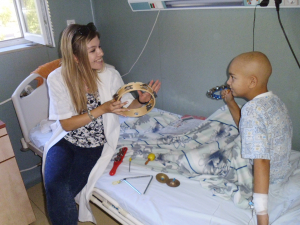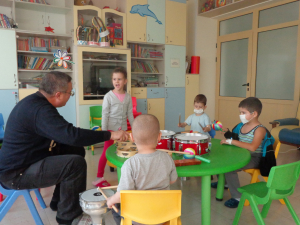
ARTON PROGRAM - The therapeutic power of the group
Creative projects involving group work - general musical performance or group painting, collage, sculpture - are useful in helping to explore and strengthen social...
Kids who seem to be stuck in a negative mood may need help to bounce back
Caroline Miller

As the pandemic continues to limit our lives, one thing we need to be alert for is depression, in our children as well as ourselves.
Feeling down in this time of cancelled activities and social distancing is unavoidable, and most of us are struggling to stay positive. But depression is more than just feeling sad or having bad days. A child who seems to be stuck in a negative mood — feeling hopeless and not able to enjoy anything — may have depression and may need help to bounce back.
Depression is a disorder that most often begins in adolescence, but it can occur in children as young as preschool age. Kids who have a history of depression are particularly at risk during this stressful time, but upsetting events like the pandemic can also trigger depression in children who haven’t shown any signs of it previously.
Mark Reinecke, PhD, a clinical psychologist, outlines three steps parents should take to guard against depression.
Depression can be easy to miss, especially in teenagers, since adolescents are often moody. But with sadness and irritability widespread during this crisis, the signs can be even easier for family members to overlook. Likewise, kids and teens who are struggling may not recognize their own symptoms for what they are.
Symptoms of depression include:
Unusual sadness or irritability, persisting even when circumstances change
Loss of interest in activities they once enjoyed
Reduced feelings of anticipation
Changes in weight
Shifts in sleep patterns
Sluggishness
Harsh self-assessment (“I’m ugly. I’m no good. I’ll never make friends.”)
Feelings of worthlessness, hopelessness
Thoughts of or attempts at suicide
If several of these symptoms are present for at least two weeks, they can suggest depression. “If you see them, take note,” advises Dr. Reinecke. “If they last, take action.”
With everyone struggling, it can be hard know how to tell the difference between a child who’s just feeling irritable or frustrated and a kid who’s slipping into depression. The watchwords, says Rachel Busman, PsyD, a clinical psychologist at the Child Mind Institute, are persistence and severity. “If it’s here today but they’re okay tomorrow, that to me is not a cause for concern,” she explains. “What’s more of a concern is when it persists. You want to be on the lookout for changes in sleep, mood, appetite, and general engagement.”
The second thing parents can do, Dr. Reinecke advises, is foster a family environment in which children feel comfortable sharing their thoughts and feelings.
Make time to sit down and explore how the kids are doing. They may need a little prompting. With so much going on in the world, older kids might worry that their feelings aren’t important, and younger kids might not have the words to explain what they’re feeling. Find a time, and if possible, a place where you aren’t likely to be interrupted. If you get in the habit of checking in with your children, and they know they’ll be listened to without judgment, they’re more likely to let you know what’s going on.
If a child is experiencing feelings of sadness or depression, take some time to talk about why. It’s easy for them to say “the virus,” and stop there. But encouraging your child to be specific can give both of you more insight into what’s happening, and how you can help. For example: Is your child struggling with boredom or from the loss of their regular activities? From disappointment over cancelled events? From feeling isolated from friends? From worries about the future, or fears that they or someone they love might get sick, or even die?
“Very often, depressed children and teens, like adults, have negative thoughts about themselves, their lives, their relationships and their future,” notes Dr. Reinecke. “They feel hopeless, helpless, and discouraged. Listen for these thoughts. Help them to clarify what’s on their mind and how they’re feeling.”
When kids do share, validate their feelings by listening to them without judgment, and without trying to “fix” them. Let them know that you hear them (without agreeing with what they’re saying) and you’re there for them. For example, “I hear that. That sounds really hard. I love you, and I’m sorry you’re feeling so sad.”
If you’re worried your child is sliding into depression, don’t panic. There are things you can do to help. Encouraging them to make changes in how they’re thinking and how they manage their feelings can help head off serious depression before it gets worse. Start by helping your child:
Stay active. Encourage kids to engage in activities that will give them a sense of accomplishment, pleasure, fun, or social connection every day. Doing something for others can lift spirits. Activity itself helps protect against (and sometimes treat) depression.
Keep a sense of perspective. People experiencing depression often magnify problems or screen out positive events and experiences. Help your child avoid exaggerating or obsessing on how bad things are right now. As parents it helps if you model this for your children, by avoiding what clinicians call “catastrophizing” – obsessing over the worst possible outcomes.
Tolerate uncertainty and ambiguity. These are uncertain times. There are no guarantees about when the pandemic will end, so we can only live with it. Mindfulness practices can help your child accept the uncertainty of the moment. You can help by expressing confidence that they can manage it.
Challenge negative thoughts. Getting stuck in negative thinking patterns that are distorted or unrealistic can contribute to depression and make painful feelings seem overwhelming. For example, your child may be thinking this will go on forever and they’ll never see their friends again. Help them think through the facts: Realistically, this will not go on forever. So, what are some things they could do to feel more connected with friends in the meantime?
Make plans. Work together to come up with a plans or activities that will help them feel more engaged. For example: If taking an online dance class would help them get some much-needed exercise, get started by looking up cool classes online and make a project of creating a practice space. Or if they just miss being social, encourage them to start a FaceTime book group, or make Zoom dates to watch a miniseries with friends. The act of making plans, completing fun tasks, and coming up with strategies, can make them feel less helpless and hopeless.
Make new goals. When you’ve lost something valued in your life, as we all have lately, it helps to find something to replace it. Help your kids make new goals. If holiday trips aren’t looking realistic, what can they focus on for next summer? What new skill can they learn that will be beneficial when this situation is over? What can they do to benefit others?
Focus on gratitude. Encourage kids to list and reflect each day on things they feel grateful for and individuals they owe thanks. How can they express that gratitude?
If your child continues to show symptoms of depression, it’s important to get professional help. Speak with your child’s pediatrician or primary care physician to get a referral for a mental health professional, or contact a mental health professional directly.
Getting teenagers into treatment for depression can take persistence, because they often feel hopeless, and they may have a hard time believing that they can get better. But treatment can really help. There are several different kinds of therapy and medication that have all been proven to be effective for children and adolescents. (Get more information about treatment for depression here.)
Many clinicians have begun seeing patients through telehealth — online or by text or phone — during the pandemic, and therapy through telehealth has been shown to be effective, too. (Get more information about telehealth here.)
In this stressful time, monitoring your own mental well-being is as important as being alert to your children’s needs. With all the competing demands on your time, self-care can seem like a luxury, but it’s not. Your mood affects your whole family, so giving yourself the attention you need — and professional help if you need it, too — is critical to the resilience you need to get through this crisis.
Article re-posted from https://childmind.org/

Creative projects involving group work - general musical performance or group painting, collage, sculpture - are useful in helping to explore and strengthen social...

In the ARTON Program our team of oncopsychologists, art therapists and music therapists develops the process of children's creativity as a process of...

In ARTON sessions, creating a piece of music or a song is an emotional experience of coping and satisfaction for the participating children. They make friends with...

Painting provides patients with a spontaneous, plastic method of depicting thoughts and experiences. Painting with paints is not as structured as with pencil or...










